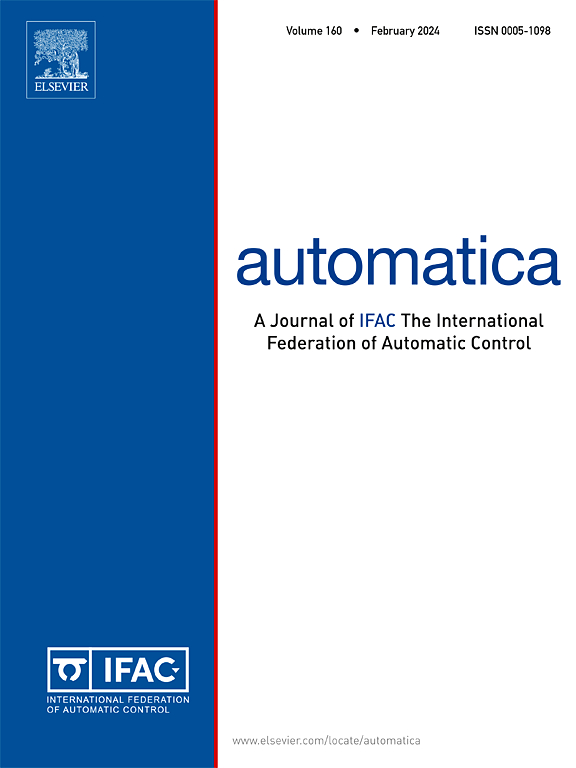布尔网络的不变对偶子空间的基本结构
IF 5.9
2区 计算机科学
Q1 AUTOMATION & CONTROL SYSTEMS
引用次数: 0
摘要
本文给出了关于布尔网络(BN)及其不变对偶子空间的研究结果。首先,我们在BN的状态集X上的对偶子空间与X的分区之间建立了一个双射,进一步证明了对偶子空间是M不变的,当且仅当BN的状态转移图的相关分区是公平的(即对于分区的每两个单元,前一个单元中的所有状态在后一个单元中具有相同数量的外邻居),其中M表示BN的状态转移矩阵。其次,我们利用公平图形表示的概念开发了一种图形算法,用于确定由一组布尔函数生成的最小m不变对偶子空间。在此基础上,我们首次给出了这些m不变对偶子空间的完整结构表征。最后,我们证明了给定一组布尔输出函数的BN是可观察的,当且仅当由该函数集生成的最小m不变对偶子空间对应的分区是离散的(即所有分区单元都是单例)。在我们的结构表征的基础上,我们引入了一种构造输出函数的方法,使BN可观察。本文章由计算机程序翻译,如有差异,请以英文原文为准。
Fundamental structures of invariant dual subspaces with respect to a Boolean network
This paper presents the following research findings on a Boolean network (BN) and the invariant dual subspaces with respect to the BN. First, we establish a bijection between the dual subspaces over the BN’s state set and the partitions of . Furthermore, we prove that a dual subspace is -invariant if and only if the associated partition of the BN’s state-transition graph is equitable (i.e., for every two cells of the partition, all states in the former cell have the same number of out-neighbors in the latter), where represents the state transition matrix of the BN. Secondly, we leverage the concept of equitable graphic representation to develop a graphical algorithm for determining the smallest -invariant dual subspaces generated by a set of Boolean functions. Based on this algorithm, we provide, for the first time, a complete structural characterization of these -invariant dual subspaces. Finally, we prove that a BN with a given set of (Boolean) output functions is observable if and only if the partition corresponding to the smallest -invariant dual subspace generated by this set of functions is discrete (i.e., all partition cells are singletons). Building upon our structural characterization, we introduce a method for constructing output functions that render the BN observable.
求助全文
通过发布文献求助,成功后即可免费获取论文全文。
去求助
来源期刊

Automatica
工程技术-工程:电子与电气
CiteScore
10.70
自引率
7.80%
发文量
617
审稿时长
5 months
期刊介绍:
Automatica is a leading archival publication in the field of systems and control. The field encompasses today a broad set of areas and topics, and is thriving not only within itself but also in terms of its impact on other fields, such as communications, computers, biology, energy and economics. Since its inception in 1963, Automatica has kept abreast with the evolution of the field over the years, and has emerged as a leading publication driving the trends in the field.
After being founded in 1963, Automatica became a journal of the International Federation of Automatic Control (IFAC) in 1969. It features a characteristic blend of theoretical and applied papers of archival, lasting value, reporting cutting edge research results by authors across the globe. It features articles in distinct categories, including regular, brief and survey papers, technical communiqués, correspondence items, as well as reviews on published books of interest to the readership. It occasionally publishes special issues on emerging new topics or established mature topics of interest to a broad audience.
Automatica solicits original high-quality contributions in all the categories listed above, and in all areas of systems and control interpreted in a broad sense and evolving constantly. They may be submitted directly to a subject editor or to the Editor-in-Chief if not sure about the subject area. Editorial procedures in place assure careful, fair, and prompt handling of all submitted articles. Accepted papers appear in the journal in the shortest time feasible given production time constraints.
 求助内容:
求助内容: 应助结果提醒方式:
应助结果提醒方式:


